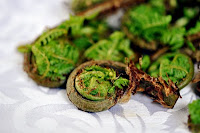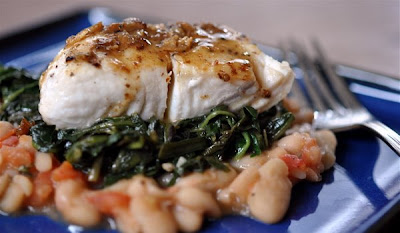
In case you haven’t noticed, dandelions have bigger brains than people. Seriously. And they get smarter each time you whack them. Mow a lawn of dandelions repeatedly and what happens? The dandelions learn to flower ever closer to the ground until those yellow Cheshire cat faces are grinning at you from beneath the grass. They know exactly how far down the cutting blade can reach, and that’s where they proliferate once again.
The other day, after harvesting a few batches of dandelion petals for Dandy Bread, I actually mowed my lawn, surprising myself even more than my neighbors. It’s been a week and the yard is already replenished with dandelions. No biggie. I picked a bunch of blooms for tempura.
Got a problem with tempura? I didn’t think so. Here at FOTL we may periodically throw a tizzy about health and nutrition and generally staving off rot, but you won’t hear a lot of griping about FAT. It’s the stuff for which our ancestors put their lives on the line. Need some fat to survive the winter? Roger that, let’s tool up and take down one of them #$*%&@ woolly mammoths again. Tucking into a bag of pork rinds doesn’t carry quite the same cachet.
 Yeah but making you own tempura and making it well is almost as cool as hurling a prehistoric projectile at an oversized elephant having a bad hair day. And while I’ve tried a bunch of tempura recipes over the years with wildly varying results, this time I think I figured out the secret. Whatever you do, make it more watery than you deem appropriate. I used a recipe found here, then tweaked it.
Yeah but making you own tempura and making it well is almost as cool as hurling a prehistoric projectile at an oversized elephant having a bad hair day. And while I’ve tried a bunch of tempura recipes over the years with wildly varying results, this time I think I figured out the secret. Whatever you do, make it more watery than you deem appropriate. I used a recipe found here, then tweaked it.
3/4 cup flour
1/4 cup corn starch
1/2 cup ice-cold water, plus extra
1 tbsp rice wine
1 egg
In a bowl mix the flour and corn starch. In a second larger bowl, beat an egg until frothy, then add the ice water and beat some more. Stir in the rice wine. Now add the dry ingredients and mix quickly, not worrying about the lumps. Don’t over-mix! If the batter oozes off a spoon, it’s too thick. Add more ice water until the batter is watery. It’ll seem way too watery if you’re used to making, say, Beer-Batter Fish and Chips, but trust me.
Now proceed over to the stove with your bowl o’ batter and a plate of dandy flowerheads. Your vegetable oil should be good and hot by now. Flick in a drop of water to see if it pops and sizzles. Using your hands, dip a dandy in the seemingly too thin gruel. The batter will run off the dandy in sheets but the flower will still be thinly coated and looking rather sad and soggy. Gently drop the dandy into the oil, petals facing down, and PRESTO! The flower opens up as if the sun has just come out. (This miracle of kitchen chemistry won’t happen if the batter is too thick and heavy.) It’s really quite amazing to see the dandy regain its form, albeit with a beautifully thin veneer of crispy tempura as its new skin.
Dandy Tempura has an unusual mouth feel. If the batter is right, the outer crust should be crispy, yet being a flower, the overall texture is squishy. I mix the dandies in with other more traditional fare: sweet potato, bell pepper, onion, and zucchini, to name a few.
Now go pick a mess of ridiculously nutritious dandelions and start frying. That’ll teach those PhD weeds!





















